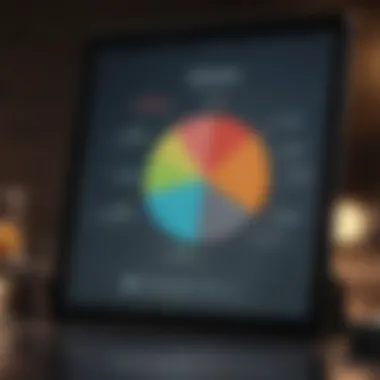Mastering Your Finances: A Guide to Budget Apps
Intro
Effective budget management is essential for personal finance success. With the rising cost of living and increasing financial responsibilities, individuals need powerful tools to assist in their budgeting efforts. Budget management apps have emerged as valuable resources to help users track their expenses and manage their finances. This guide will explore these applications in detail, focusing on their features, effectiveness, and overall impact on personal financial well-being.
Market Insights
Current Trends and Developments
Today’s market for budget management applications is dynamic. Many people are turning to technology for financial support. There is a noticeable increase in demand for user-friendly apps that can simplify the budgeting process. Features like automated expense tracking, bank integration, and personalized budgeting are increasingly popular. Developers are focusing on enhancing usability to attract a larger audience.
Market Analysis and Predictions
Experts predict continued growth in the budget management app market. As financial literacy becomes more important, people are looking for tools that provide insight into their spending habits. Apps that offer educational resources, such as saving tips or investment advice, are expected to gain traction. Additionally, collaboration with financial institutions could lead to even more refined applications with tailored features.
Sector-Specific Insights
The personal finance sector is shifting towards increased digital solutions. This includes not only budgeting apps but also comprehensive financial planning tools. Users are looking for all-in-one solutions that can manage multiple financial aspects such as saving, investing, and debt management. Such integrations may encourage a more holistic approach to personal finance.
"Budget management tools empower users to make informed financial decisions by offering real-time insights into their financial health."
Personal Finance Tips
Budgeting and Saving Strategies
Implementing effective budgeting strategies is crucial. Users should start by identifying their income and categorizing their expenses. Expense categories can include rent, utilities, groceries, and discretionary spending. Using budget apps can help track these expenditures in real-time, which aids in adjusting habits where necessary.
Debt Management Tips
Managing debt is another essential expertise supported by budget apps. Users often benefit from features that allow them to set goals for debt repayment. Creating a debt payoff plan and monitoring progress through the app can motivate users to stay committed to their financial goals. This kind of strategy enhances not only awareness but also accountability.
Retirement Planning Guidance
Planning for retirement requires foresight and discipline. Budget management apps can play a key role in this process. They can help users allocate savings towards retirement accounts, analyze long-term spending trends, and adjust financial strategies as retirement approaches. A proactive approach ensures that individuals avoid last-minute scrambles to save money.
Case Studies and Success Stories
Real-Life Practical Examples
Examining real-life successes enhances understanding. For instance, a young professional began using a budget app to analyze their spending habits. They implemented a strict savings plan, which allowed them to save for a home within three years.
Personal Finance Transformation Journeys
The story of a family struggling with credit card debt showcases the power of budget apps. By diligently recording expenses and utilizing the app’s debt management features, their financial situation significantly improved. Within eighteen months, they paid off their credit cards and established a solid emergency fund.
As the awareness of budgeting apps grows, the importance of proper personal finance management continues to rise. These applications provide users not only with insights into their financial habits but also empower them to make informed decisions that lead to long-term financial stability.
Prelims to Budget Management
Effective budget management is a cornerstone of financial stability. It plays a crucial role in helping individuals allocate their resources efficiently while allowing them to meet both short-term and long-term financial goals. By understanding how to manage a budget, one can gain insights into spending habits, identify areas for improvement, and ultimately, cultivate healthier financial practices.
Understanding Budget Management
Budget management involves creating a structured financial plan that quantifies income and expenses over a specified period. This process helps individuals or businesses grasp where their money goes and encourages informed spending. A comprehensive budget reflects priorities and can adjust to changing circumstances. It is not merely about restricting spending, but rather about maximizing the utility of every dollar spent.
To effectively manage a budget, one must first assess their financial situation. This includes documenting all sources of income, along with fixed and variable expenses. A clear understanding of these factors enables a realistic budget to emerge, paving the way for sound financial decisions.
The Role of Technology in Financial Management
In recent years, technology has transformed the landscape of financial management. Budget management apps have gained traction as powerful tools that simplify the way people handle their finances. With features designed to automate many aspects of budgeting, these applications alleviate the burden of manual tracking. This shift not only saves time but also reduces errors commonly associated with traditional methods of budget management.
The advantages of using budget management apps are manifold. They offer features such as real-time expense tracking, income management, and even predictive analytics, promoting a proactive approach to finances. Moreover, these tools often provide reporting functionalities, allowing users to visualize their financial health through engaging charts and graphs. By embracing technology, individuals can enhance their financial literacy and make informed decisions based on data rather than guesswork.
"With the right tools and mindset, anyone can master their budget and steer their financial future towards success."
What is a Budget Management App?
Budget management apps have become essential tools for individuals seeking to take control of their finances. These applications facilitate monitoring, organizing, and optimizing personal financial data. They are designed to track incomes, expenditures, and forecast future financial scenarios. Understanding what a budget management app is and its purposes can significantly enhance financial decision-making.
Definition and Purpose
A budget management app is a digital tool that enables users to plan their finances according to their income and spending habits. The primary purpose of these apps is to provide users with a clear overview of their financial status. By categorizing expenses and comparing them against income, users can identify areas where they may need to adjust their spending. With the right budget management app, individuals can foster better financial habits and lay the groundwork for achieving their larger financial goals. The importance lies in its ability to streamline budgeting processes in a manner that was once tedious and time-consuming.
Core Features of Budget Apps


When considering budget management apps, several core features differentiate them. These features contribute significantly to their overall effectiveness, enhancing user experience and financial insight.
Expense Tracking
Expense tracking is perhaps the most fundamental function of any budget management app. It involves monitoring where and how money is spent. This aspect directly contributes to understanding spending patterns, which is vital for making informed financial decisions. The key characteristic of expense tracking is its ability to categorize expenditures into necessary areas such as groceries, utilities, and entertainment.
Unique Feature: Many apps allow users to sync their bank accounts for real-time tracking.
Advantages: Real-time data updates offer instant insights into financial activity, aiding users in adjusting their habits promptly. However, it can be overwhelming for some users, especially when too much data is presented at once, potentially complicating straightforward budgeting tasks.
Income Management
Income management is essential for users aiming to balance their expenses with earnings effectively. This feature allows for the organization and categorization of different income sources, be it salaries, freelance earnings, or passive income streams. The key characteristic of income management is its function in providing a comprehensive view of total income versus expenditures, ensuring that users remain within their financial limits.
Unique Feature: Automated income updates based on bank transaction data simplify tracking.
Advantages: By understanding income streams better, individuals can apply surplus funds more strategically toward savings or investments. On the downside, reliance on such features may lead to underestimating irregular earnings, impacting budgeting negatively.
Reporting Tools
Reporting tools present a summary of financial activity over specified periods, enabling users to visualize trends in their spending or savings. The key characteristic of reporting tools is their ability to generate insights through charts and graphs, thus facilitating understanding of complex financial data.
Unique Feature: Customizable reports that allow users to focus on specific categories or timeframes.
Advantages: This feature empowers users by providing them with clear visual representations of their financial progress. However, creators might develop reports that are too complicated for casual users, potentially limiting accessibility and increasing frustration.
User-Friendly Interfaces
User-friendly interfaces are critical in determining how effectively a budget management app can be utilized. A simple, intuitive design enables users to navigate the app without a steep learning curve. The key characteristic is a layout that clearly displays financial information without unnecessary clutter.
Unique Feature: Apps that offer personalized dashboards that highlight the most relevant financial data for the user.
Advantages: A well-designed interface encourages regular use and keeps users engaged with their budgeting efforts. Conversely, overly simplistic designs may lack depth and functionality, leading to a less comprehensive budget management experience.
Selecting the Right Budget App
Choosing the appropriate budget management app is crucial for effective personal finance management. With a plethora of options available, understanding specific features and functionalities is vital. The right app can simplify tracking expenses and managing income, thus fostering better financial habits.
Users often feel overwhelmed by the choices. However, by focusing on their needs and preferences, they can identify an app that aligns with their financial goals. Not all apps cater to every user's requirements; therefore, making a well-informed choice is important to ensure long-term satisfaction and usability.
Key Considerations
When selecting a budget app, several key factors must be evaluated. Each consideration plays a unique role in determining which app is the best fit for an individual’s financial situation.
Personal Financial Goals
Defining personal financial goals is an essential first step. This aspect outlines the specific objectives that users wish to achieve, such as saving for a vacation or eliminating debt. The key characteristic of this is clarity. When users clearly identify their goals, they can effectively track relevant progress within the app.
Having set goals can increase motivation. Most budget apps allow users to integrate their personal objectives directly into the budgeting process. However, setting overly ambitious goals can be challenging to maintain, leading to frustration. Users must strike a balance between ambition and realism to foster consistent app usage.
Budgeting Methodologies
Budgeting methodologies refer to the different systems used for tracking income and expenses. Popular methodologies include the zero-based budgeting approach, where every dollar has a purpose, and the 50/30/20 rule, which divides income into needs, wants, and savings. Each method serves a different budgeting style. Some users may prefer a structured approach, while others may resonate with a more variable system.
Key characteristics of these methodologies impact users' engagement with the app. When an app supports a method that aligns with a user's natural tendencies, adherence to budgeting may improve significantly. On the downside, users may find themselves confused if the app does not support their preferred budgeting style, thus hindering their ability to manage finances effectively.
Integration with Other Financial Tools
Integration capabilities allow users to connect their budget app with other financial tools, such as saving accounts or investment platforms. This feature serves to consolidate financial management into one environment. The ability to view all financial data in one place enhances decision-making.
A significant characteristic of financial integrations is automation. Many apps can sync transactions automatically, saving users valuable time. Nevertheless, this feature comes with potential drawbacks. Users should remain cautious about linking too many accounts, leading to mismanagement of finances if overlooked. It is essential to balance convenience with effective oversight of personal finances.
Comparative Analysis of Popular Apps
To provide a clearer view of the market, users should analyze popular budget management apps available. Each app has unique strengths and potential weaknesses that cater to different financial needs. Key metrics to consider include performance, synchronization capabilities, user feedback, cost, and adaptability to personal financial goals.
The comparative analysis should involve practical testing if possible. Users can utilize free trials or demo versions to evaluate the usability of an app before fully committing. This exercise allows for an experiential understanding of how well an app performs in real-world scenarios, making the selection process more refined and user-focused.
By assessing key considerations and employing a comparative analysis, individuals can find a budget management app that genuinely serves their needs, ultimately leading to better financial outcomes.
Popular Budget Management Apps
The emergence of budget management apps has transformed the landscape of personal finance. These applications offer users tools to effectively track spending, manage income, and plan for future expenses. With a plethora of options available, understanding the strengths and features of popular budget apps becomes crucial for anyone looking to manage their finances better. Each app caters to different needs, making it essential to identify one that aligns with personal financial goals.


Some key benefits include:
- Accessibility: Users can access their budget data from anywhere, anytime, using their smartphones or computers.
- Real-time Tracking: Many apps offer instant updates to spending or income, providing users with timely insights.
- Enhanced Engagement: Gamification elements in some apps can motivate users towards better financial habits.
Selecting the right app can lead one towards improved financial literacy, ensuring more informed decisions. Now, let's analyze some of the most popular budget management apps available today.
Mint
Mint is one of the leading budgeting apps in the market. Developed by Intuit, it consolidates all financial accounts in one place, offering a comprehensive overview. Users can link bank accounts, credit cards, and loans, allowing for seamless tracking of financial activities.
Key features of Mint include:
- Budgeting: The app helps set realistic budgets based on user spending patterns.
- Alerts and Notifications: Users receive alerts for upcoming bills and overspending, which can help avoid late fees.
- Credit Score Monitoring: Mint provides free access to credit reports and scores, which can be crucial for financial planning.
The app is free, making it an attractive option for those wanting to manage their budgets without incurring additional costs.
You Need a Budget (YNAB)
You Need a Budget, commonly known as YNAB, is designed for proactive budgeting. It emphasizes the principle of assigning every dollar a job, which can help users gain control over their financial situation.
YNAB's standout features are:
- Real-time Budgeting: Users can track expenses in real-time, improving their financial awareness.
- Goal Setting: The app allows users to set financial goals like saving for a vacation or paying off debt.
- Educational Resources: YNAB offers webinars and classes to help users understand budgeting principles better.
This app carries a subscription fee, but many consider it a worthwhile investment for the financial discipline it fosters.
PocketGuard
PocketGuard is designed with simplicity in mind. It helps users understand how much disposable income is available after accounting for necessary expenses, bills, and goals. This feature is beneficial for minimizing overspending.
Some features of PocketGuard include:
- In My Pocket: This unique feature shows how much money is available for spending after deducting bills and savings goals.
- Custom Categories: Users can create specific categories for personal spending, making it easier to track where money goes.
- Automatic Updates: The app syncs with bank accounts to provide real-time updates on spending patterns.
The user-friendly interface makes PocketGuard a strong option for those who may find budgeting overwhelming.
GoodBudget
GoodBudget employs the envelope budgeting system in a digital format. This app is designed to help track expenditures and manage money without linking to bank accounts, promoting a cash-only approach.
Key aspects of GoodBudget include:
- Envelope System: Users allocate money to different envelopes for various spending categories, making it easy to stay within budget.
- Cross-Platform: GoodBudget works on both mobile devices and desktop, adding flexibility.
- Manual Entry: Since the app does not automatically sync with bank accounts, users manually input transactions, encouraging mindful spending.
GoodBudget is particularly appealing for those who prefer a hands-on approach to their finances.
User Experiences with Budget Apps
User experiences with budget apps provide valuable insights into how these tools can effectively assist in personal finance management. Understanding both the triumphs and the setbacks faced by users allows potential adopters to make informed decisions. Moreover, real-world applications and reactions can present an authentic picture of budget apps, highlighting what works well and what may pose challenges.
Success Stories
Many users of budget apps have reported significant improvements in their financial situation. For example, individuals who faced difficulties in tracking their spending began using apps like Mint or You Need a Budget. Upon implementing these budget tools, they often experienced a renewed sense of control over their finances.
- Reduced Debt: Users have eliminated credit card debt by adhering to budgeting plans outlined in their apps. These applications provide real-time tracking and reminders that keep users accountable.
- Savings Goals: Many individuals have successfully achieved savings goals through structured budgeting. Utilizing the feature to set aside funds for emergencies or specific purchases has made the process more tangible and rewarding.
- Financial Awareness: Regular use of budget apps has cultivated a deeper financial consciousness among users. They can see where their money goes, allowing for more mindful spending habits.
These success stories illustrate how budget apps have become instrumental in guiding users towards financial prudence and responsibility.
Common Challenges
While many users find success with budget apps, some encounter various challenges. These experiences can serve as cautionary tales for potential users. Common obstacles often include:
- Technical Issues: Some users report difficulties with app stability or glitches that interfere with usability. A budget app that frequently crashes could lead to frustration and decreased engagement.
- Self-Discipline: Ensuring consistent tracking takes a level of commitment that some users struggle to maintain. Without regular entries, the app can lose its effectiveness and fail to provide accurate financial insights.
- Overwhelming Features: Numerous apps include a vast array of features that, while useful, can also overwhelm users, especially those who prefer simplicity in managing their finances. Navigating complicated functionalities can detract from the primary goal of budgeting.
"Experiences can vary widely depending on personal goals and tech savviness. Users should assess their preferences before choosing an app."
By exploring both the success stories and common challenges surrounding budget app usage, one can gain a balanced understanding of their potential impact on personal financial management.
Benefits of Using Budget Management Apps
Budget management apps offer various advantages that assist individuals in taking control of their finances. They can be especially useful for those seeking to better track their spending habits, set financial goals, and ultimately achieve a more stable economic future. The core benefits of these apps are essential for any user, regardless of their financial background.
One significant advantage is the capability to gain improved financial awareness. By utilizing these applications, users can classify their expenses and see their spending habits laid out clearly. This visibility is crucial. It helps in identifying unnecessary expenditure or where budget adjustments are required. The act of tracking finances can itself promote increased mindfulness about spending. Thus, budget apps empower users to be more informed about their everyday financial decisions.


Another critical aspect is the element of goal setting and progress tracking. Many budgeting applications have features that allow individuals to set financial objectives, whether that’s saving for a major purchase or paying off debt. The ability to create goals makes the budgeting process feel more manageable. Users can break their financial aspirations into smaller, achievable steps and monitor their progress regularly. This method fosters a sense of accomplishment as users can visually see their financial improvements.
Improved Financial Awareness
Improved financial awareness through budget management apps essentially provides users with the data needed for making informed decisions. The integration of expense tracking in these applications allows users to categorize their expenditures, providing insights into whether they are sticking to budget or overspending.
Some key features include:
- Customized categories for tracking spending habits
- Visualization tools like charts for easy understanding
- Automated alerts for reaching budget limits
This immediate feedback helps users remain accountable for their financial behaviors. Security and privacy, however, do play a role when selecting an app. Some users may worry about their data being shared. It's crucial to choose apps known for robust security protocols.
"Awareness is the first step to financial wellness."
Employing these apps can lead to a shift in how a person perceives their financial behavior. With consistent tracking, users often realize that small changes in their daily spending can lead to significant savings over time.
Goal Setting and Progress Tracking
Goal setting and progress tracking is another crucial benefit of budget management apps. These applications encourage individuals to define what they wish to achieve financially and help facilitate tracking those goals. A well-structured goal setting process consists of defining, measuring, and reviewing objectives regularly.
This section introduces functionalities that support users:
- SMART Goals: Specific, Measurable, Achievable, Relevant, and Time-bound criteria help frame their financial ambitions.
- Progress Tracking: Users can see how far they are from their objectives, and most apps provide visualizations to make this even clearer.
- Reminders and Notifications: Many apps send alerts for approaching deadlines or when users are nearing financial limits, keeping them engaged in their budgeting journey.
Ultimately, the satisfaction of achieving defined goals can reinforce the habit of budgeting. Users learn that discipline leads to results, enhancing their confidence, and pushing them to set even more challenging financial aspirations.
Potential Drawbacks of Budget Apps
Budget management apps present a wide array of benefits. However, it is critical to acknowledge their potential drawbacks. Users must weigh these issues against the advantages to make informed decisions regarding their personal finance tools. For many, understanding these drawbacks can be just as important as recognizing the benefits.
Privacy Concerns
One significant drawback tied to budget management apps is the potential for privacy issues. Users often share sensitive financial information when setting up these applications. This can include bank account numbers, credit card details, and personal identification. Data breaches or unauthorized access can pose risks to users’ finances and identity.
Many app developers claim to prioritize data security, implementing encryption and other security measures. However, breaches still occur, leading to disillusionment among customers.
"The risk of sharing personal financial details remains a top concern for many users of budget apps."
Users should keenly assess the privacy policies of a budget app before committing. Researching how data is stored, shared, and protected is crucial. It is also wise to consider apps with transparent operations and a good reputation among users.
Over-Reliance on Technology
Another drawback is an over-reliance on technology. While budget apps can aid in managing finances effectively, they can also lead to dependency. Users might become complacent, relying solely on the app without fully understanding their financial situation. This dependency could hinder financial literacy and decision-making.
Furthermore, technology can fail. Outages, software bugs, or updates can hinder access to financial data. This lack of access may leave users unprepared during crucial financial moments, like bill payments or emergency expenses.
To combat this, users should strive to balance the convenience of apps with a solid understanding of their finances. Regularly reviewing personal financial statements, setting budgets manually, and learning core financial principles can lead to a more robust financial mindset.
Future Trends in Budget Management Apps
The landscape of budget management apps is evolving rapidly. Users increasingly expect not just functionality, but also innovative features that cater to their unique financial needs. The future trends in these applications can significantly enhance personal finance efficiency. Understanding these trends is vital for users looking to make informed choices about their financial tools. Here are two pivotal areas to consider.
Integration of AI in Personal Finance
Artificial Intelligence (AI) is set to revolutionize the personal finance sector. By integrating AI, budget management apps can offer tailored solutions that learn from user behavior. For example, an AI-driven app can analyze spending patterns and suggest adjustments to improve budgeting strategies. It can also provide predictive insights based on historical financial data. This predictive capability can help users anticipate future expenditures, making it easier to avoid overspending.
Moreover, AI can enhance user support through virtual assistants. Users can interact with these assistants to ask questions or get tips on financial management, improving user experience. The ability to receive personalized financial advice within the app itself adds significant value.
Enhanced User Customization
Customization is becoming a core expectation among users of budget management apps. As users’ financial situations and goals vary widely, the demand for customizable features is growing. Enhanced user customization allows individuals to tailor their dashboards, notifications, and budgeting strategies according to their preferences.
Users should have the option to select which financial metrics they want to prioritize. This could include features like savings goals, debt repayment plans, or even investment tracking. Such personalization ensures that users engage with their budget management app as a tool that fits their lifestyle rather than a one-size-fits-all solution.
The future of budget management apps looks promising with these trends. By embracing AI and prioritizing user customization, developers can create more efficient and user-friendly financial tools. As the technology advances, tailoring personal finance strategies will not just be easier, but also more intuitive for the average user.
End
In the realm of personal finance, effective budget management stands as a crucial element for achieving financial stability and growth. This article emphasizes the significant role that budget management apps play in assisting individuals to navigate their financial landscapes. By utilizing such tools, users can transform their approach to budgeting through organized tracking of income and expenses, setting realistic financial goals, and enhancing overall financial awareness.
Summary of Key Insights
Throughout this article, several pivotal insights emerge regarding budget management apps. Firstly, the core features that these apps provide—such as expense tracking, income management, and user-friendly interfaces—are essential for daily financial management. Secondly, selecting the right app is limited not just to personal preference, but should align with one's financial goals and methodologies.
"Choosing a budget app is not just about functionality; it’s about compatibility with your unique financial journey."
Lastly, the evolving landscape of technology, particularly with the integration of artificial intelligence and enhanced customization options, sets the stage for a more tailored budgeting experience. Users are encouraged to embrace these advancements and adapt their budgeting practices as new features emerge.
Final Thoughts on Budget Management
Budget management is a continuous process that requires diligence and adaptation. While budget management apps offer convenience and efficiency, it is essential for users to engage actively with their financial data. The combination of technology and personal initiative can lead to informed financial decisions that support long-term success. Users must remain vigilant about privacy concerns and the potential for over-reliance on these technologies. The insights and strategies presented in this guide can serve as a foundation for enhancing personal finance skills, providing the tools needed for a more secure financial future.



